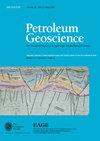Petroleum source rocks characterisation and depositional environment of Kimmeridgian-Tithonian Sequences, Jaisalmer Basin, Western Rajasthan, India
IF 1.9
4区 地球科学
Q3 GEOSCIENCES, MULTIDISCIPLINARY
引用次数: 0
Abstract
In hydrocarbon exploration, total organic carbon content (TOC) and Rock-eval pyrolysis are commonly employed geochemical techniques that offer concise insights into kerogen type, effective source rock identification, and thermal maturity. In the current study, the data obtained from Rock-eval pyrolysis has been used for defining the source rock quality, generative potential, kerogen type, maturity of the source sediments, and kerogen kinetics of the Baisakhi-Bhadesar Formation of Kimmeridgian -Tithonian (154.7−145.6 Ma) age. Basinal level HI, TOC, source rock maturity, transformation ratio, and heat flow maps have been generated by integrating the data from pyrolysis and the previously available data from wells drilled in the basin. The Total Organic Carbon (TOC) content of the Kimmeridgian-Tithonian sequence ranges from 0.03 to 12.71% in the studied samples, with an average TOC content of 1.28 %, indicating good source rock quality. The Hydrogen index (HI), in collaboration with T max and VRo data, demonstrates that the Baisakhi - Bhadesar Formation is characterised by type II, mixture of type II/ III and type III kerogen facies and exhibits good source quality and poor to good generative potential in the basin. The studied samples are marginally mature to mature in nature (Tmax 430-450 0 C, VRo % ranges from 0.52% to 0.72%). Maturity analysis of the basin suggests that, during the Late Jurassic, most areas were under the oil window zone, except the Bhakhari Tibba and Miajlar areas. The Transformation ratio overlay for the Kimmeridgian-Tithonian source sequences shows better transformations of the source rock in the area of the Shagarh sub-basin. Kerogen kinetics of the studied Baisakhi-Bhadesar Formation demonstrate that the activation energy ranges between 46-74 Kcal/mol with the significant distribution of activation energy 54 Kcal/mol (42.07 %), representing a strong heterogeneous type of organic matter in the sediments. Based on lithological, paleontological, and electrolog studies, a shallow marine to near-shore environment of deposition with sediment input direction from the southeast has been inferred for Kimmeridgian-Tithonian Sequences. The results of this study quantitatively establish the role of the Kimmeridgian-Tithonian sequence as source rock, ultimately contributing to the generation of hydrocarbons in the basin along with spatial changes in the quality of source sediments in different parts of the basin.印度西拉贾斯坦邦杰萨尔梅尔盆地金梅利期-提托尼期地层的石油源岩特征和沉积环境
在碳氢化合物勘探中,总有机碳含量(TOC)和岩石-评价热解是常用的地球化学技术,可提供有关角质类型、有效源岩识别和热成熟度的简明见解。在当前的研究中,岩石-评价热解所获得的数据被用于确定金梅里德-蒂吞纪(154.7-145.6 Ma)Baisakhi-Bhadesar 地层的源岩质量、生成潜力、角质类型、源沉积物的成熟度以及角质动力学。通过整合热解数据和盆地内钻井获得的数据,绘制了基底层 HI、总有机碳(TOC)、源岩成熟度、转化率和热流图。在所研究的样本中,金梅里德-提托尼统序列的总有机碳(TOC)含量从 0.03% 到 12.71% 不等,平均 TOC 含量为 1.28%,表明源岩质量良好。氢指数(HI)与最大 T 值和 VRo 数据共同表明,Baisakhi-Bhadesar 地层的特征为 II 型、II/III 型混合型和 III 型角质层,在盆地中显示出良好的源岩质量和较差到良好的生成潜力。所研究的样本在性质上属于微成熟至成熟(Tmax 430-450 0 C,VRo % 在 0.52% 至 0.72% 之间)。盆地的成熟度分析表明,在晚侏罗世期间,除 Bhakhari Tibba 和 Miajlar 地区外,大部分地区都处于石油窗口区之下。金梅里晚期-始新统岩源序列的转化率叠加显示,沙加尔子盆地地区的岩源转化率较高。所研究的 Baisakhi-Bhadesar 地层的岩浆动力学表明,活化能介于 46-74 Kcal/mol 之间,活化能的显著分布为 54 Kcal/mol (42.07%),表明沉积物中的有机物具有很强的异质性。根据岩石学、古生物学和电学研究,推断金梅里德纪-提托尼世序列的沉积环境为浅海至近海,沉积物的输入方向为东南。这项研究的结果从数量上确定了金美里革-蒂吞统序列作为源岩的作用,最终促进了盆地碳氢化合物的生成,以及盆地不同地区源沉积物质量的空间变化。
本文章由计算机程序翻译,如有差异,请以英文原文为准。
求助全文
约1分钟内获得全文
求助全文
来源期刊

Petroleum Geoscience
地学-地球科学综合
CiteScore
4.80
自引率
11.80%
发文量
28
审稿时长
>12 weeks
期刊介绍:
Petroleum Geoscience is the international journal of geoenergy and applied earth science, and is co-owned by the Geological Society of London and the European Association of Geoscientists and Engineers (EAGE).
Petroleum Geoscience transcends disciplinary boundaries and publishes a balanced mix of articles covering exploration, exploitation, appraisal, development and enhancement of sub-surface hydrocarbon resources and carbon repositories. The integration of disciplines in an applied context, whether for fluid production, carbon storage or related geoenergy applications, is a particular strength of the journal. Articles on enhancing exploration efficiency, lowering technological and environmental risk, and improving hydrocarbon recovery communicate the latest developments in sub-surface geoscience to a wide readership.
Petroleum Geoscience provides a multidisciplinary forum for those engaged in the science and technology of the rock-related sub-surface disciplines. The journal reaches some 8000 individual subscribers, and a further 1100 institutional subscriptions provide global access to readers including geologists, geophysicists, petroleum and reservoir engineers, petrophysicists and geochemists in both academia and industry. The journal aims to share knowledge of reservoir geoscience and to reflect the international nature of its development.
文献相关原料
| 公司名称 | 产品信息 | 采购帮参考价格 |
|---|
 求助内容:
求助内容: 应助结果提醒方式:
应助结果提醒方式:


